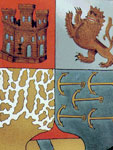BROWSE BY CATEGORY
- Archives and Libraries
- Blogs and Networking
- Bookmark This
- Digital Tools
- Examples of Teaching
- Exhibits
- Film Reviews
- History and Headlines
- Historic Sites and Museums
- Historical Thinking
- Holidays and Heritage
- Issues and Research
- Lesson Plans
- Material and Visual Culture
- Multimedia
- Organizations and Agencies
- Primary Sources
- Professional Development
- Publications
- Student Activities
- Teaching Materials
- Websites
Jennifer Orr on Questioning Columbus

History is complicated and in our attempts to simplify it for young children we often change it, sometimes drastically. The story of Christopher Columbus is one example. For generations we have passed down myths about this man. We have taught children that he alone believed the world was round, when, in truth, many if not most people of his time understood that the world is round. We have taught that he discovered a new world. How could he discover it if people were already living there? We have also taught that he died not realizing what he had 'discovered.'
Elementary school teachers have a unique challenge: they teach all subjects rather than focus on one. Not surprisingly, it is difficult to be experts in everything.
One way to address this challenge is to allow students to recognize the questions. We don't have to have all the answers. In fact, when it comes to history it is not possible to know all the answers. Historians continue to study a wide range of primary sources and to disagree with previous assertions and with each other. It is important that students be allowed to wrestle with this uncertainty rather than to blindly accept what we state as fact. Even the youngest children can understand that adults are still learning, and can enjoy learning along with us.
If you are interested in tackling the complexities of Christopher Columbus, there are some great places to start. James Loewen's book, Lies My Teacher Told Me: Everything Your American History Textbook Got Wrong, is a good one and helpful for subjects far beyond Columbus. The Library of Congress has an exhibit entitled 1492: An Ongoing Voyage that includes interesting information on Columbus's coat of arms. An examination and discussion of his coat of arms can encompass quite a bit of information about the man and his achievements. The Gilder Lehrman Institute of American History's June 2007 History Now includes an article detailing the benefits and difficulties faced by both Columbus and his men and those people already living in the New World. If you are interested in the geography of Columbus's journeys or his logs, one individual has created a site which includes maps and information about the logs, navigation, the ships, and the crew.
One thing children can understand about Columbus and what he achieved was that he did so by "standing on the shoulders of giants" (a phrase from Isaac Newton). Columbus learned from those who came before him, about navigation, geography, and other cultures. Learning from others and building on that knowledge are strategies we should be helping our students develop. That is a worthy lesson to take from Columbus.
For more information
Try our quiz on Christoper Columbus's portraits!
